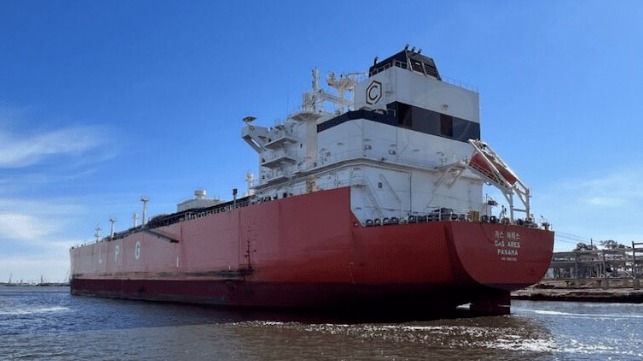NTSB: Pilot Error Caused $1M in Damages as LPG Carrier Hit Docked Tugs

A pilot’s mistaken judgment regarding the speed of the gas carrier that was being navigated to berth in Port Neches, Texas a year ago resulted in more than $1 million in damages according to a newly released report from the National Transportation Safety Board. The safety board was investigating the causes of an allision in which the liquefied petroleum gas carrier Gas Ares hit tugs moored on the Neches River on November 25, 2021.
Built in 2020 and owned by the South Korean company KSS Line, Gas Ares was transiting upbound on the Neches River with 24 persons. The 53,900 dwt vessel the NTSB reports had taken aboard a state-licensed pilot from the Sabine Pilots who took navigational control of the gas carrier as it was heading to a loading dock on the Neches River.
Reconstructing the orders given as the vessel was making the river transit, the NTSB reports the pilot decided to reduce the ship’s speed to create less wake when passing a pipeline removal project, which was underway as part of the effort to deepen the channel.
The pilot made the decision to slow the vessel’s speed despite the presence of a strong crosswind. The gas carrier had previously been operating at half ahead, or at 8.1 knots. In anticipation of passing the pipeline removal project, the pilot ordered the Gas Ares to dead slow ahead, and about six minutes later, the vessel was only making about 3.8 knots as it approached the piers.
The NTSB believes that the vessel encountered a north-northwesterly wind at 18 to 27 knots that exerted pressure on the exposed (in-ballast) starboard-side hull above the waterline. They say the river’s current was not impacting the vessel. Already positioned toward one side of the channel, the pilot ordered the stern tug to pull the Gas Ares stern back to starboard and the center of the channel. But instead of righting the vessel, that then caused the LPG carrier’s bow to point more toward the left side of the channel and the moored vessels. Without enough headway, the pilot was unable to steer the vessel back to the center of the channel and avoid striking the moored tugs.
The NTSB analyzed the Gas Ares design reporting that the 754-foot-long vessel had a single right-hand-turning propeller directly driven by a slow-speed diesel main engine. It had a single rudder and was not outfitted with a bow thruster.
“With the reduction of the ship’s speed, the Gas Ares’s rudder became less effective, and was not able to move the vessel to starboard and away from the moored vessels on the left side of the channel by rudder and engine alone or by using the escort tug to pull on the vessel’s starboard quarter,” concludes the NTSB report. “Without enough headway, the pilot was unable to steer the vessel back to the center of the channel and avoid striking the outboard moored tug.”
The Motiva no. 1 loading dock, which had two harbor tugs moored side by side alongside the dock, was ahead of the Gas Ares on the south shoreline on the LPG carrier’s port bow. The tug Sabine was outboard on the channel side with the tug Florida moored inboard and alongside the dock, both facing up river.
Veering to the side of the river, Gas Ares struck the outboard tug, the Sabine. No injuries or pollution was reported although the collision resulted in damages to the tugs and dock estimated at $1,057,000.

that matters most
Get the latest maritime news delivered to your inbox daily.
The port bow of the Gas Ares sustained minor damage consisting of an indentation and scratch in the shell plating above the waterline while the Sabine sustained damages to its starboard main engine/generator stack plating, anchor handling boom, onboard image recording system, and about 11 feet of its starboard bulwarks and starboard rubber fendering. The Florida sustained damages to its no. 2 port wing fuel tank and starboard-side shell plating near the engine room. The Motiva dock sustained damages to its pilings, steel beams that supported the concrete deck, the concrete surface, and mooring dolphins with the cost of repairs estimated to be $967,000.
According to the report, the pilot was a senior deputy pilot for the Sabine Pilots and was qualified to pilot vessels with a beam of less than 40 meters such as the Gas Ares. The pilot had been with the Sabine Pilots for about three years at the time of the accident.
